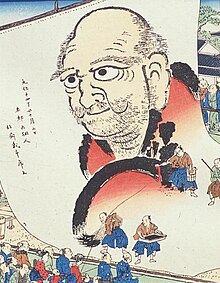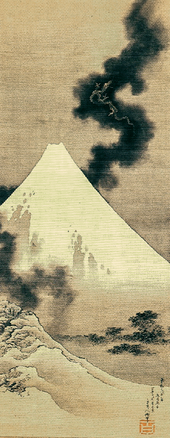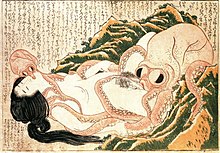Hokusai
Biography
| Hokusai (北斎 ) | |
|---|---|
 Katsushika Hokusai, in an 1839 self-portrait | |
 listen , c. October 31, 1760 – May 10, 1849) was a Japanese artist, ukiyo-e painter and printmaker of the Edo period. Born in Edo(now Tokyo), Hokusai is best known as author of the woodblock print series Thirty-six Views of Mount Fuji (富嶽三十六景 Fugaku Sanjūroku-kei, c. 1831) which includes the internationally iconic print, The Great Wave off Kanagawa.
listen , c. October 31, 1760 – May 10, 1849) was a Japanese artist, ukiyo-e painter and printmaker of the Edo period. Born in Edo(now Tokyo), Hokusai is best known as author of the woodblock print series Thirty-six Views of Mount Fuji (富嶽三十六景 Fugaku Sanjūroku-kei, c. 1831) which includes the internationally iconic print, The Great Wave off Kanagawa.Hokusai created the Thirty-Six Views both as a response to a domestic travel boom and as part of a personal obsession with Mount Fuji. It was this series, specifically The Great Wave print and Fine Wind, Clear Morning, that secured Hokusai’s fame both in Japan and overseas. As historian Richard Lane concludes, "Indeed, if there is one work that made Hokusai's name, both in Japan and abroad, it must be this monumental print-series". While Hokusai's work prior to this series is certainly important, it was not until this series that he gained broad recognition.
Early life and artistic training
Hokusai's date of birth is unclear, but is often stated as the 23rd day of the 9th month of the 10th year of the Hōreki era (in the old calendar, or October 31, 1760) to an artisan family, in the Katsushika district of Edo, Japan. His childhood name was Tokitarō. It is believed his father was the mirror-maker Nakajima Ise, who produced mirrors for the shogun. His father never made Hokusai an heir, so it is possible that his mother was a concubine. Hokusai began painting around the age of six, perhaps learning from his father, whose work on mirrors included a painting of designs around mirrors.
Hokusai was known by at least thirty names during his lifetime. While the use of multiple names was a common practice of Japanese artists of the time, his number of pseudonyms exceeds that of any other major Japanese artist. Hokusai's name changes are so frequent, and so often related to changes in his artistic production and style, that they are used for breaking his life up into periods.
At the age of 12, his father sent him to work in a bookshop and lending library, a popular type of institution in Japanese cities, where reading books made from wood-cut blocks was a popular entertainment of the middle and upper classes. At 14, he worked as an apprentice to a wood-carver, until the age of 18, when he entered the studio of Katsukawa Shunshō. Shunshō was an artist of ukiyo-e, a style of woodblock prints and paintings that Hokusai would master, and head of the so-called Katsukawa school. Ukiyo-e, as practised by artists like Shunshō, focused on images of the courtesans and Kabuki actors who were popular in Japan's cities at the time.
After a year, Hokusai's name changed for the first time, when he was dubbed Shunrō by his master. It was under this name that he published his first prints, a series of pictures of Kabuki actors published in 1779. During the decade he worked in Shunshō's studio, Hokusai was married to his first wife, about whom very little is known except that she died in the early 1790s. He married again in 1797, although this second wife also died after a short time. He fathered two sons and three daughters with these two wives, and his youngest daughter Ei, also known as Ōi, eventually became an artist.
Upon the death of Shunshō in 1793, Hokusai began exploring other styles of art, including European styles he was exposed to through French and Dutch copper engravings he was able to acquire. He was soon expelled from the Katsukawa school by Shunkō, the chief disciple of Shunshō, possibly due to studies at the rival Kanō school. This event was, in his own words, inspirational: "What really motivated the development of my artistic style was the embarrassment I suffered at Shunkō's hands."
Hokusai also changed the subjects of his works, moving away from the images of courtesans and actors that were the traditional subjects of ukiyo-e. Instead, his work became focused on landscapes and images of the daily life of Japanese people from a variety of social levels. This change of subject was a breakthrough in ukiyo-e and in Hokusai's career. Fireworks at Ryōgoku Bridge (1790) dates from this period of Hokusai's life.
Height of career
The next period saw Hokusai's association with the Tawaraya School and the adoption of the name "Tawaraya Sōri". He produced many brush paintings, called surimono, and illustrations for kyōka ehon (illustrated book of humorous poems) during this time. In 1798, Hokusai passed his name on to a pupil and set out as an independent artist, free from ties to a school for the first time, adopting the name Hokusai Tomisa.
By 1800, Hokusai was further developing his use of ukiyo-e for purposes other than portraiture. He had also adopted the name he would most widely be known by, Katsushika Hokusai, the former name referring to the part of Edo where he was born and the latter meaning, 'north studio'. That year, he published two collections of landscapes, Famous Sights of the Eastern Capital and Eight Views of Edo. He also began to attract students of his own, eventually teaching 50 pupils over the course of his life.
He became increasingly famous over the next decade, both due to his artwork and his talent for self-promotion. During a Tokyo festival in 1804, he created a portrait of the Buddhist priest Daruma said to be 600 feet (180 m) long using a broom and buckets full of ink. Another story places him in the court of the Shogun Ienari, invited there to compete with another artist who practised more traditional brush stroke painting. Hokusai's painting, created in front of the Shogun, consisted of painting a blue curve on paper, then chasing across it a chicken whose feet had been dipped in red paint. He described the painting to the Shogun as a landscape showing the Tatsuta River with red maple leaves floating in it, winning the competition.
1807 saw Hokusai collaborate with the popular novelist Takizawa Bakin on a series of illustrated books. The two did not get along due to artistic differences, and their collaboration ended during work on their fourth book. The publisher, given the choice between keeping Hokusai or Bakin on the project, opted to keep Hokusai, emphasizing the importance of illustrations in printed works of the period.
Hokusai paid close attention to the production of his work in books. Two instances are documented in letters he wrote to the publishers and block cutters involved in the production of his designs in Toshisen Ehon, a Japanese edition of an anthology of Chinese poetry. Hokusai writes to the book’s publisher that the blockcutter Egawa Tomekichi, with whom Hokusai had previously worked and whom he respected, had strayed from Hokusai’s style in the cutting of certain heads. Hokusai also wrote directly to another block cutter involved in the project, Sugita Kinsuke, stating that he disliked the Utagawa-school style in which Kinsuke had cut the figure’s eyes and noses and that amendments would need to be made for the final prints to be true to Hokusai’s style. In his letter, Hokusai includes illustrated examples of both his style of illustrating eyes and noses and the Utagawa–school style. The publisher agreed to make these alterations, even with hundreds of copies of the book already printed. To correct these details the already existing cut blocks would be corrected by use of the Umeki technique. The sections to be corrected would be removed and a prepared piece of wood inserted, into which the blockcutter would cut the revised design. Use of the Umeki technique can be detected by fine break marks bordering the inserted block. Copies in print of both the original woodblock and those made of Hokusai’s requested revisions survive, printed in 1833 and 1836 respectively.
In 1811, at the age of 51, Hokusai changed his name to Taito and entered the period in which he created the Hokusai Manga and various etehon, or art manuals. These etehon, beginning in 1812 with Quick Lessons in Simplified Drawing, served as a convenient way to make money and attract more students. Manga (meaning random drawings) included studies in perspective. The first book of Hokusai's manga, sketches or caricatures that influenced the modern form of comics known by the same name, was published in 1814. Together, his 12 volumes of manga published before 1820 and three more published posthumously include thousands of drawings of animals, religious figures, and everyday people. They often have humorous overtones and were very popular at the time.
On October 5, 1817, he painted at the Hongan-ji Nagoya Betsuin in Nagoya the Big Daruma on paper, measuring 18x10.8 metres, impressing many onlookers. For this feat he received the name "Darusen" (a shortened form of Daruma Sensei). Although the original was destroyed in 1945, promotional handbills from that time survived and are preserved at the Nagoya City Museum. Based on studies, a reproduction of the large painting was done at a large public event on 23 November 2017 to commemorate the 200-year anniversary of the painting, using the same size and techniques and material as the original.
In 1820, Hokusai changed his name yet again, this time to "Iitsu," a change which marked the start of a period in which he secured fame as an artist throughout Japan. His most famous work, Thirty-six Views of Mount Fuji, including the famous Great Wave off Kanagawa, was produced in the early 1830s. The results of Hokusai's perspectival studies in Manga can be seen here in The Great Wave off Kanagawa where he uses what would have been seen as a western perspective to represent depth and volume. It proved so popular that Hokusai later added ten more prints to the series. Among the other popular series of prints he published during this time are A Tour of the Waterfalls of the Provinces, Oceans of Wisdom and Unusual Views of Celebrated Bridges in the Provinces. He also began producing a number of detailed individual images of flowers and birds, including the extraordinarily detailed Poppies and Flock of Chickens.
Later life
The next period, beginning in 1834, saw Hokusai working under the name "Gakyō Rōjin Manji" (The Old Man Mad About Art). It was at this time that Hokusai produced Thirty-six Views of Mount Fuji, another significant landscape series.
In the postscript to this work, Hokusai writes:
In 1839, a fire destroyed Hokusai's studio and much of his work. By this time, his career was beginning to fade as younger artists such as Andō Hiroshige became increasingly popular. But Hokusai never stopped painting and completed Ducks in a Stream at the age of 87.
Constantly seeking to produce better work, he apparently exclaimed on his deathbed, "If only Heaven will give me just another ten years... Just another five more years, then I could become a real painter." He died on May 10, 1849 (18th day of the 4th month of the 2nd year of the Kaei era by the old calendar), and was buried at the Seikyō-ji in Tokyo (Taito Ward).
Shunga
Hokusai also executed erotic art, called Shunga in Japanese. Most shunga are a type of ukiyo-e, usually executed in woodblock print format. Translated literally, the Japanese word shunga means picture of spring; "spring".
Shunga was enjoyed by both men and women of all classes. Superstitions and customs surrounding shunga suggest as much; in the same way that it was considered a lucky charm against death for a samurai to carry shunga, it was considered a protection against fire in merchant warehouses and the home. From this, we can deduce that samurai, chonin, and housewives all owned shunga. All three of these groups would suffer separation from the opposite sex; the samurai lived in barracks for months at a time, and conjugal separation resulted from the sankin-kōtai system and the merchants' need to travel to obtain and sell goods. Records of women obtaining shunga themselves from book lenders show that they were consumers of it. It was traditional to present a bride with ukiyo-e depicting erotic scenes from The Tale of Genji. Shunga may have served as sexual guidance for the sons and daughters of wealthy families.
Works and influences
Hokusai had a long career, but he produced most of his important work after age 60. His most popular work is the ukiyo-e series Thirty-six Views of Mount Fuji, which was created between 1826 and 1833. It actually consists of 46 prints (10 of them added after initial publication). In addition, he is responsible for the 1834 One Hundred Views of Mount Fuji (富嶽百景 Fugaku Hyakkei), a work which "is generally considered the masterpiece among his landscape picture books." His ukiyo-e transformed the art form from a style of portraiture focused on the courtesans and actors popular during the Edo period in Japan's cities into a much broader style of art that focused on landscapes, plants, and animals.
Both Hokusai's choice of art name and frequent depiction of Mount Fuji stem from his religious beliefs. The name Hokusai (北斎) means "North Studio (room)," an abbreviation of Hokushinsai (北辰際) or "North Star Studio." Hokusai was a member of the Nichiren sect of Buddhism, who see the North Star as associated with the deity Myōken (妙見菩薩). Mount Fuji has traditionally been linked with eternal life. This belief can be traced to The Tale of the Bamboo Cutter, where a goddess deposits the elixir of life on the peak. As Henry Smith expounds, "Thus from an early time, Mt. Fuji was seen as the source of the secret of immortality, a tradition that was at the heart of Hokusai's own obsession with the mountain."
The largest of Hokusai's works is the 15-volume collection Hokusai Manga (北斎漫画), a book crammed with nearly 4,000 sketches that was published in 1814. These sketches are often incorrectly considered the precedent to modern manga, as Hokusai's Manga is a collection of sketches (of animals, people, objects, etc.), different from the story-based comic-book style of modern manga.
Selected works
 Fine Wind, Clear Morning,
Fine Wind, Clear Morning,
from Thirty-six Views of Mount Fuji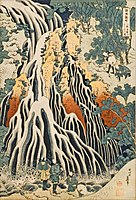 Kirifuri waterfall at Kurokami Mountain in Shimotsuke,
Kirifuri waterfall at Kurokami Mountain in Shimotsuke,
from A Tour of Japanese Waterfalls Cuckoo and Azaleas, 1834
Cuckoo and Azaleas, 1834
from the Small Flower series Shunga, from Pining for Love
Shunga, from Pining for Love The Ghost of Oiwa,
The Ghost of Oiwa,
from One Hundred Ghost Tales Courtesan asleep
Courtesan asleep Still Life
Still Life The Yodo River [Moon],
The Yodo River [Moon],
from Snow, Moon, Blossoms Tenma Bridge in Setsu Province,
Tenma Bridge in Setsu Province,
from Rare Views of Famous Japanese Bridges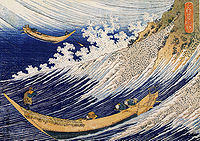 Chōshi in Shimosha,
Chōshi in Shimosha,
from One Thousand Images of the Sea Lake Suwa in Shinano Province,
Lake Suwa in Shinano Province,
from Rare Views of Famous Landscapes Carp Leaping up a Cascade
Carp Leaping up a Cascade The Strong Oi Pouring Sake
The Strong Oi Pouring Sake Yoshino Waterfalls, where Yoshitsune Washed his Horse,
Yoshino Waterfalls, where Yoshitsune Washed his Horse,
from A Tour of Japanese Waterfalls
Influences on art and culture
His influences also stretched to his western contemporaries in nineteenth-century Europe whose new style Art Nouveau, or Jugendstil in Germany, was influenced by him and by Japanese art in general. This was also part of the larger Impressionism movement, with similar themes to Hokusai appearing in Claude Monet and Pierre-Auguste Renoir. According to the Brooklyn Rail Many artists collected his woodcuts: Degas, Gauguin, Klimt, Franz Marc, August Macke, Manet, and van Gogh included. Hermann Obrist's whiplash motif, or Peitschenhieb, which came to exemplify the new movement, is visibly influenced by Hokusai's work.
A much more direct influence was Japonism, "which started with a craze for collecting Japanese art, particularly ukiyo-e, of which some of the first samples were to be seen in Paris: In about 1856 the French artist Félix Bracquemond first came across a copy of the sketchbook Hokusai Manga at the workshop of his printer."
Hokusai inspired the Hugo Award-winning short story by science fiction author Roger Zelazny, "24 Views of Mt. Fuji, by Hokusai", in which the protagonist tours the area surrounding Mount Fuji, stopping at locations painted by Hokusai.
A 2011 book on mindfulness closes with the poem "Hokusai Says" by Roger Keys, preceding it with the explanation that "[s]ometimes poetry captures the soul of an idea [here, mindfulness] better than anything else."
One assessment describes Hokusai as, "since the later nineteenth century [having] impressed Western artists, critics and art lovers alike, more, possibly, than any other single Asian artist."
Hokusai was also influenced by Sesshū Tōyō and other styles of Chinese painting.



